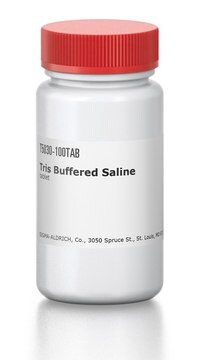480012
NDSB Set
Contains the following non-detergent sulfobetaines: 5 g of NDSB-195, 25 g of NDSB-201, and 5 g of NDSB-256.
Se connecterpour consulter vos tarifs contractuels et ceux de votre entreprise/organisme
About This Item
Code UNSPSC :
12352200
Nomenclature NACRES :
NA.21
Produits recommandés
Niveau de qualité
Forme
solid
Fabricant/nom de marque
Calbiochem®
Conditions de stockage
OK to freeze
desiccated (hygroscopic)
Solubilité
water: 50 mg/mL
Conditions d'expédition
ambient
Température de stockage
15-25°C
Description générale
Contains the following non-detergent sulfobetaines: 5 g of NDSB-195 (Cat. No. 480001), 25 g of NDSB-201 (Cat. No. 480005), and 5 g of NDSB-256 (Cat. No. 480010). Supplied with a data sheet.
Non-detergent sulfobetaines (NDSBs) are zwitterionic compounds. Like zwittergents (zwitterionic detergents), NDSBs carry the sulfobetaine hydrophilic head group. However, unlike zwittergents, the hydrophobic group in NDSBs is too short for micellar formation even at concentrations as high as 1M. Hence, NDSBs do not behave like detergents. Because of their zwitterionic nature, NDSBs were first employed to neutralize electrostatic interactions without increasing the conductivity in native isoelectrofocusing gels. Recently they have found utility in various other applications including isolation of membrane proteins, purification of nuclear proteins and halophilic proteins, renaturation of chemically and thermally denatured proteins and protein crystallization. They are potentially useful in solubilization and renaturation of fusion proteins from inclusion bodies. It is hypothesized that the hydrophobic group, although short, interacts with the hydrophobic regions of the protein preventing aggregation during renaturation. Also, presumably, the contribution from the short hydrophobic groups combined with charge neutralization ability of the sulfobetaine group results in higher yields of membrane proteins.
NDSBs do not interfere with enzymatic assays based on chromogenic substrates bearing nitrophenyl groups and do not inhibit the activities of β-galactosidase and alkaline phosphatase, the two enzymes tested thus far. NDSB-195 has the added advantage in that it does not absorb at 280 nm, making it compatible with protein purification procedures in which the protein concentrations are determined by absorbance measurements at 280 nm. Supplied with a data sheet.
NDSBs do not interfere with enzymatic assays based on chromogenic substrates bearing nitrophenyl groups and do not inhibit the activities of β-galactosidase and alkaline phosphatase, the two enzymes tested thus far. NDSB-195 has the added advantage in that it does not absorb at 280 nm, making it compatible with protein purification procedures in which the protein concentrations are determined by absorbance measurements at 280 nm. Supplied with a data sheet.
Avertissement
Toxicity: Irritant (B)
Reconstitution
Store lyophilized products at room temperature. Following reconstitution, store in the refrigerator (4°C) or at room temperature (20°C).
Autres remarques
Goldberg, M.E., et al. 1996. Folding and Design1, 21.
Goldberg, M.E., et al. 1995. Folding & Design1, 21.
Vuillard, L., et al. 1995. Biochem. J.305, 337.
Vuillard, L., et al. 1995. Anal. Biochem.230, 290.
Vuillard, L., et al. 1994. FEBS Lett.353, 294.
Goldberg, M.E., et al. 1995. Folding & Design1, 21.
Vuillard, L., et al. 1995. Biochem. J.305, 337.
Vuillard, L., et al. 1995. Anal. Biochem.230, 290.
Vuillard, L., et al. 1994. FEBS Lett.353, 294.
Informations légales
CALBIOCHEM is a registered trademark of Merck KGaA, Darmstadt, Germany
Code de la classe de stockage
11 - Combustible Solids
Certificats d'analyse (COA)
Recherchez un Certificats d'analyse (COA) en saisissant le numéro de lot du produit. Les numéros de lot figurent sur l'étiquette du produit après les mots "Lot" ou "Batch".
Déjà en possession de ce produit ?
Retrouvez la documentation relative aux produits que vous avez récemment achetés dans la Bibliothèque de documents.
Notre équipe de scientifiques dispose d'une expérience dans tous les secteurs de la recherche, notamment en sciences de la vie, science des matériaux, synthèse chimique, chromatographie, analyse et dans de nombreux autres domaines..
Contacter notre Service technique







